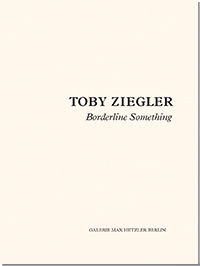
|
|
|||
Toby Ziegler: Borderline Something English |
TOBY ZIEGLER, SILENT LIVES The title of the exhibition is Borderline Something. And borderline it is, in several different respects: borderline between sculpture/painting/drawing in space and between abstraction and figuration. It becomes impossible to opt for one thing or another. All Ziegler’s work is intended to erode such distinctions: we sometimes recognise objects but only as formal motifs under the patterns of spray. This strange relationship between figuration and abstraction might seem to echo an oeuvre that Ziegler is happy to cite: the later works of Philip Guston, which are being more and more observed by a young generation of artists. An example. The fold in Memling’s rug is a motif exemplifying both illusionism and two-dimensionality. Ziegler’s decision to cover the space just above the ‘break’ zone (the junction with the plane of the table) by an increasingly thick veil of paint is a concrete illustration of his ‘borderline’ stance. The same might be said of his treatment of an almost empty fragment of Meléndez’s Still Life with Oranges and Walnuts (1772). Ziegler has singled out a corner ‘with nothing in it’, a dark zone disrupted only by the top of a barrel, which one can just make out toward the bottom. Further on, another picture: the pile of books similarly extracted from a Meléndez painting has become a pile of geometrical blocks. This connection between abstraction and figuration also leads to the fusion of sculpture and painting, already unified by their common iconography and sources. A fusion accentuated by Ziegler in the form of the structure that carries almost the entire exhibition and itself fluctuates between two worlds: those of drawing/sculpture and architecture/furniture... One final aspect deserves our attention: the titles of the works in this exhibition are all taken from famous sunken ships, the majority of them in fact celebrated for their wreckage. And if the figure of shipwreck particularly interests Ziegler, his paradigm is the description given by Conrad in his autobiographical novella Youth. An old sailor tells of his first voyage to the Far East on board a vile old tub that is literally smashed to pieces by the successive catastrophes that mark the passage. But the obstinate captain hangs on to the last remaining planks in an effort to steer what remains of his ship to its destination. Disintegration: now that we come to think of it, what could be more obvious? It is at work too in the explosive dispersal of sources, motifs, objects; the slow disintegration of things allowing them to be seen in a new light, in all their facets – and even from within, allowing us still closer to the object. A chimerical vision quite exceptionally translated by Michelangelo Antonioni in the last scene of Zabriskie Point. This exhibition is a similar experience, at once more analytic in structure and looser in its texture. The matter of which objects are made is detached from their form, and what remains is frame or surface, a structure around which orbits the brute flesh. The disintegration is almost but not perfectly complete. On the verge. Borderline.
...
|